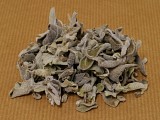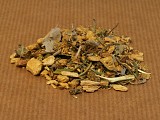Leaves, Bundle Extra Large from United States (SKU 5189)
This Sagebrush is wild harvested in the North American South West deserts and steppes. It has been used by the Native American tribes in this area for hundreds of years in healing ceremonies, banishing of negative energies and was seen as a powerful herbal incense.
Dimensions: 23 x 4 cm. Approximate weight: 40-55 gr.
Desert sage grows on the high deserts in the West of the United States. It is especially known for its pleasant fragrance and is traditionally used in ceremonies and included in pouches and bundles. Sage is used in smudging ceremonies to drive out bad spirits, feelings or influences. Traditional stories and myths tell of the power of Sage in that wherever Sage is present negative forces cannot enter. In the Inipi (sweat lodge) ceremony, a sprig of Sage is worn behind the right ear to protect the participant and placate the little people. The leaves are valued for their aromatic properties and are used as a natural moth repellent.
Other names: Artemisia tridentata, Big Sagebrush, Big Sage
Big Sagebrush was commonly used by many Native Americans, such as the Navajo. The wood was burned for fuel or used in construction of dwellings. The leaves and the seeds were also eaten. The leaves contains Camphor (Cinnamomum camphora). Navajo weavers boiled the leaves and flowers to create a yellow-gold color, used to dye wool. Ute Indians wove the shredded bark into wicks for candles, and they made sacks of woven bark and lined them with the grass. Native Americans of the Plains Nations cover the floor of their sweat lodge with Sage. They will also breathe through a small bundle of Sage and at times rub the bundle on their bodies while in the sweat lodge. Some tribes commonly wrapped their pipes in Sage before they bundled them up. They believed that objects wrapped in Sage were purified.
Waist to chest high shrub, measuring between two and five feet. This shrub has grey-green-silvery leaves, tri-lobed and measuring about one inch. This plant is famous for its pungent terpentine fragrance. Big Sagebrush gets its name from its stature and its relation to members of the Sagebrush group. Artemisia is from Artemisia, wife of Mausolus, ancient ruler of Ceria (southwest Asia Minor). She was named after Artemis, the Greek virgin goddess of the hunt and wild nature. Tridentata means "three toothed," in reference to the three lobes on the tips of most leaves.
Sagebrush has a strong, pungent, woody scent.
Sagebrush is considered as one of the most sacred herbs among the Native Americans. The benefits of Sagebrush can be experienced in a ritual called "smudging ceremony", which involves burning the leaves on charcoal or in a bundle. The smoke is said to attach to negative energies and carry them away. Sagebrush stands for the air-element. You can smudge persons, stones, spaces and other objects. The properties of Sagebrush are deeply purifying (negative spirits and thoughts), clearing and cleansing. The word Sage comes from the Latin word "Salvare", to heal. Sometimes people carry a leaf of Sagebrush with them (in a talisman pouch for example) for protection.
Blends well with Sweetgrass, Lavender, Cedar, Mugwort, Juniper, Yerba Santa, Rosemary, Copal, Palo Santo.
This item is not allowed in the following countries:
Taiwan, Taiwan
This is a natural product, used as incense or in perfumery, or as an ingredient of incense and other perfumery or potpourri preparations.
Some incense plants or products may have some history of other folklore purposes, but we offer this product for its use as incense. Not food grade, not for consumption.
Please read our Terms & Conditions before placing your order.



















